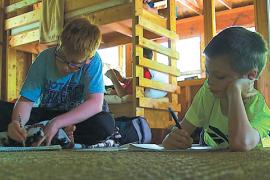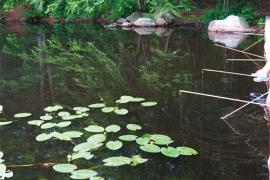Rain doesn't have to be an unwelcome guest at your camp. It can be an inspiration for camp activities. Rainy days offer an opportunity to teach campers more about weather and for them to see firsthand how rain affects plants, animals, and the environment.
Though you may be undaunted, you should not be oblivious to the weather conditions. Staff training should include sessions on recognizing storm conditions, reviewing emergency plans, and planning all-camp program alternatives. Remember never to go outdoors during a severe thunderstorm or when there is lightning.
Rainy Day Activities
With a little ingenuity, you can plan activities around a rain theme. For example, using the following questions, have campers develop ideas for activities:
- What do you know about rain? About weather generally? What else would you like to know? How can we find out?
- Name some things you can do with/in a puddle.
- Where does the drinking water we use in camp come from? How is it purified? Where does our waste water go? What would we have to do to find out?
- What are some things we could make inside today that we might use outside in the sunshine tomorrow?
- Is there something that needs cleaning that the rain might help us wash? Can we conduct the activity suggested with out damaging the earth?
- What wildlife would we be more likely to see on a rainy day than on a sunny day? What might those animals be doing right now?
- If at this moment we were backpacking, how would we likely spend our rainy day? What could we have packed or could we be creating that might be making our trip more bearable?
Following are some ideas for other rain-inspired activities that campers might enjoy.
Ducks Play Outside on Rainy Days, Why Not Me?
A rainy-day hike in the woods can give campers ages five to seven a new look at the environment. Before setting out on the hike, ask campers to demonstrate the appropriate dress for rainy weather. Have a bag filled with various things, such as suntan lotion, sunglasses, swim mask, fins, and snorkel, umbrella, waders, rain boots with tread for safe hiking, rain poncho or coat, and a first-aid kit. As campers pull items from the bag, ask them to tell you why some are appropriate and others are not. For example, an umbrella is not much good on a hike in the woods because you need both hands to climb and also the umbrella might get stuck in the branches and hurt someone or significantly slow you down. You might also show campers how to protect their boots so their feet stay dry.
Observing the differences
When campers are dressed for the hike, divide them into small groups and give each group a plastic bag with a small notebook and pen. Tell them that the purpose of the hike is to look for things that look, feel, sound, or smell differently in the rain. Ask them to write down things they see along the way in their notebook or to make sketches of what they see. Also, remind them to check changes in the condition of the sky.
When you return from the hike, have towels ready for campers to dry off. If it is a cool day, you might plan a warm shower or build a fire in a shelter or building where the group can dry off and warm up. Then have campers share their observations. Can they imitate the sound of the rain, make up their own rain dance, or draw a picture of how rain makes them feel? Follow up by reading a book with a rain theme, such as A Rainy Day by Sandra Markle or Cloudy with a Chance of Meatballs by Judi Barrett.
Water, Water Everywhere, but Not Much to Drink
Campers ages eight to ten may be interested in learning how the earth’s water supply is distributed. You need eleven empty gallon milk jugs, an eyedropper, and a measuring cup. Display ten of the milk jugs. Fill only the remaining jug with water and set it aside.
Tell campers that the ten gallon jugs represent all of the water on earth. Then ask them where they think that water is located. After some discussion and with your help, campers should determine that nine-and-a-half gallons are located in the world’s oceans. This water is valuable for sea life, but not available for use in homes. That leaves only one-half gallon of water for human consumption.
Pour one-half gallon of water from the full jug into the last empty jug in the display line. Hold up this jug and ask campers where they think most of this remaining water is located. This question is more difficult, but they will probably come up with the correct answer, the ice caps. This water is not readily available to humans either.
Only a small portion is available
Pour one cup of water from the remaining one-half gallon into the measuring cup and set it in front of the display jugs. Tell them that the cup represents the water that is left. It must be shared between all the humans, animals, and plants on earth. Ask them where they think this water is located. The correct answers are lakes, rivers, ponds, creeks, and ground water.
Then take the eyedropper and fill it from the cup of water. Tell them that ten drops of water represents the clean water left on earth. The remaining water in the cup is busy circulating in the water cycle, being purified for later use. All of the fresh water, except the ten drops extracted by the eyedropper must be cleaned before we can use it. Tell them that having enough clean water for a growing population is one of our country’s greatest concerns.
What can we do to conserve?
Slowly drop ten drops of water back into the cup. Then ask campers what they can do to help save water. Possible responses are: use only the water we really need, use a cup when we brush our teeth, put a brick in the toilet bowl, use rinse water from clothes and dishwashing to water plants, and limit the use of chemicals.
Creek Clean-up
Youth, ages eleven to fourteen, can adopt a safe waterway on or near the camp property to free of debris and litter. You will need sturdy garbage bags and a method of hauling heavy trash to the appropriate dumping area. This project can be conducted rain or shine, and campers should always work in groups of at least two. Remember, creeks swollen with rain water can be dangerous, so take appropriate safety precautions.
Following the clean-up, build a campfire on the creek bank and prepare lunch. While resting, discuss the effects of litter and trash on waterways and the environment.
Water’s “Skin”
For this activity, you will need a pie pan, a clear bowl filled with water, and marbles. Ask campers if they think a bowl completely full of water will hold any marbles, and if so, how many.
Directions
Begin by setting the bowl in the pie pan to avoid spills. Campers inspect the bowl to see that is full. Carefully roll one marble at a time down the side of the bowl.
Observations
The water will swell up above the bowl, but will not spill over. Ask campers how a bowl full of water could hold marbles. The answer is that water has a characteristic called cohesion or we say that water has a skin.
Molecule Movement
You will need a pie pan, a variety of colors of food coloring, milk, and liquid dishwashing detergent. Ask campers what they think will happen to food coloring floating on milk when detergent is added.
Directions
Fill the pie pan about half full of milk. Carefully put several drops of different colors of food coloring on the milk (it will float). Drop one drop of dish detergent along the inside of the pie pan and observe what happens. Empty the pan and repeat the activity.
Observations
Generally, water molecules stick together, which is why the food coloring floats on top of the milk. The detergent causes the water molecules to separate, breaking the food coloring into tiny droplets. This is what happens when you wash clothes or take a bath. The soap causes the water molecules to separate so the soil can be washed away.
Rainy days don’t have to mean a washout for fun. With a little planning and imagination, you can keep campers entertained and maybe even teach them a little bit about the world around them.
An Experiential Experience
Camps often avoid the scientific track that many of these activities suggest. Perhaps because camp staff think these activities should be left to the school classroom or because they feel they lack information. The limits of the classroom often prohibit engagement in experiential activities that can be much more easily executed in camp settings, and campers often know much of the information already and enjoy applying it in real-life settings. And when campers or counselors don’t know the answers, the information is readily available on the Internet and often in the camp library.
Indoor Activities Are Fun, Too
Traditional indoor activities can also be fun on a rainy day, especially when the weather is too severe to go outdoors. Campers can make boats, pinwheels, boomerangs, airplanes, and rockets to float, spin, or fly when the sun shines. Indoor moments are great times for telling stories and dramatizing them using people or puppets. And a rainy day can also be a good time to learn the art of book binding. Campers enjoy making scrapbooks or journals to preserve sketches and drawings, record words to a favorite song, express their innermost thoughts, or keep original poetry.
Originally published in the 1999 May/June issue of Camping Magazine.


